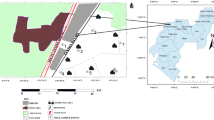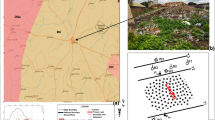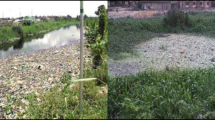Abstract
This research deals with detecting the underground layer geometrics and conditions, probable faults and crushed zones, thickness of alluvium, determination of pollutant plume development, and groundwater quality in the study area. The Visual HELP and HYDRUS programs were used to evaluate hydrologic properties and contaminant transport, respectively. All required data which consisted of the geotechnical study (drilling the borehole and dug well), the geophysical study (geoelectrical sounding), and geochemical analysis of water and leachate samples were collected in the field operations. According to the results of ten years of hydrologic data evaluation of this site by using the Visual HELP program, the mean rate of leachate percolation from this site was equal to 1.095 m per year. From the interpretation of the vertical electrical resistivity soundings curves which was calibrated by the geotechnical borehole log, a four-layer geoelectrical model was recognized. These layers consisted of surface layer (loose and fine grained topsoil), medium grained alluvium, saturated layer, and high resistivity bedrock. The physico-chemical analysis of ten surface and groundwater sample indicated that these samples were not contaminated by leachate yet. Based on 1D, 2D and 3D modeling of contaminant transport using the HYDRUS 1D and the HYDRUS 2D/3D program, during the ten years of the onset of leachate seepage, contaminant plume migrated a short distance (<200 m) due to high compaction of fine grain sediments. In addition, the high compaction of a third layer (M3) in a depth of more than 40 m introduces a natural barrier to infiltration and movement of contaminant to the deep subsurface.














Similar content being viewed by others
References
Albaiges J, Casado F, Ventura F (1986) Organic indicators of groundwater pollution by a sanitary landfill. Water Res 20(9):1153–1159
Aldecy AS, Shiraiwa S, Alexandra NOS, Édina CRFA, Neli AS, Silveira A (2008) Evaluation on surface water quality of the influence area of the sanitary landfill. Engenharia Ambiental Pesquisa e Tecnologia 5(2):139–151
Alloway BJ, Ayres DC (1997) Chemical principles of environmental pollution (Second edition). Waste and other multipollutant situation. P 357. Blackie A & P. ISBN 0-7514-0380-6
American Public Health Association (APHA) (1998) American water works association, water environment federation. Standard methods for examination of water and wastewater (20th.). New York, USA: American Public Health Association
Bear J, Sorek S, Borisov V (1995) On the Eulerian–Lagrangian formulation of balance equations in porous media. Num Methods Partial Differ Equs 13(5):505–530
Butow E, Holzbecher E, Kob E (1989) Approach to model the transport of leachates from a landfill site including geochemical processes, contaminant transport in groundwater. Kobus and Kinzelbach, Balkema, pp 183–190
Christensen JB, Jensen DL, Gron C, Filip Z, Christensen TH (1998) Characterization of the dissolved organic carbon in landfill leachate-polluted groundwater. Water Res 32(1):125–135
Domenico PA, Schwartz FW (1998) Physical and chemical hydrogeology, 2nd edn. Wiley, New York, p 506
Dunlap WJ, Shew DC, Robertson JM, Tossaint CR (1976) Organics pollutants contributed to groundwater by a landfill. In: Genetelli EJ, Cirello J (Eds.), Gas and leachate from landfill: formation, collection, and treatment. EPA-600-9-76-004
El-Fadel M, Findikakis A, Leckie J (1997a) Environmental impacts of solid waste landfilling. J Environ Manage 50(1):1–25
El-Fadel M, Findikakis A, Leckie J (1997b) Modeling leachate generation and transport in solid waste landfills. Environ Technol 18:669–686
Gandola F, Sander GC, Braddock RD (2001) One dimensional transient water and solute transport in soils. In: Ghassemi F, Post D, Sivapalan M, Vertessy R (eds) MODSIM, natural systems (Part one), vol 1. MSSANZ, Canberra
Garland G, Mosher D (1975) Leachate effects from improper land disposal. Waste Age 6:42–48
Jhamnani B, Singh SK (2009) Migration of organic contaminants from landfill: minimum thickness of barriers. Open Environ Pollut Toxicol J 1:18–26
Lashkaripour GhR, Nakhaei M (2005) Geoelectrical investigation for the assessment of groundwater conditions: a case study. Ann Geophys Italy 48(6):937–944
Lee GF, Jones RA, Ray C (1986) Sanitary landfill leachates recycle. Biocycle 27:36–38
Longe EO, Enekwechi LO (2007) Investigation on potential groundwater impacts and influence of local hydrogeology on natural attenuation of leachate at a municipal landfill. Intl J Environ Sci Technol 4(1):133–140
Longe EO, Kehinde MO (2005) Investigation of potential groundwater impacts at an unlined waste disposal site in Agege, Lagos, Nigeria. Proceeding of 3rd International Conference, Faculty of Engineering, University of Lagos, Lagos, May 23–26, pp 21–29
MacFarlane DS, Cherry JA, Gillham RW, Sudicky EA (1983) Migration of contaminants in groundwater at a landfill: a case study. J Hydrol 63:1–29
Malina G, Szczypior B, Ploszaj J, Rosinska A (1999) Impact on ground water quality from sanitary landfills in Czestochowa region-Poland: a case study. In: Christensen TH, Cossu R, Stegman R (eds) Sardinia 99: seventh waste management and landfill symposium, vol IV, 4–8 October, Cagliary, Sardinia, Italy. CISA Environmental Sanitary Engineering Center, Cagliary
Meju MA (2000) Geoelectrical investigation of old and abandoned, covered landfill sites in urban areas: model development with a genetic diagnosis approach. J Appl Geophys 44(2–3):115–150
Mor S, Ravindra K, Dahiya RP, Chandra A (2006) Leachate characterization and assessment of groundwater pollution near municipal solid waste landfill site. Environ Monit Assess 118(1–3):435–456
Mualem Y (1976) A new model for predicting the hydraulic conductivity of unsaturated porous media. Water Resour Res 12(3):513–522
Nixon WB, Murphy RJ, Stessel RI (1997) An empirical approach to the performance assessment of solid waste landfills. London, Royaume-Uni, Sage of local hydrogeology on natural attenuation of leachate at a municipal landfill. Int J Environ Sci Tech 4(1):133–140
Ogundiran OO, Afolabi TA (2008) Assessment of the physicochemical parameters and heavy metal toxicity of leachates from municipal solid waste open dumpsite. Int J Environ Sci Tech 5(2):243–250
Radcliffe DE, Šimůnek J (2010) Soil physics with HYDRUS, CRC Press, Taylor & Francis Group, Boca Raton, FL, ISBN: 978-1-4200-7380-5, pp. 373
Reinhard M, Goodman NL, Barker JF (1984) Occurrence and distribution of organic chemicals in landfill leachate plumes. Environ Sci Technol 18:953–961
Ryding SO (1992) Environmental management handbook. The holistic approach from problem to strategies. IOS Press. ISBN 9051990626, 9789051990621
Schaap MG, Leij FJ, van Genuchten MTh (2001) Rosetta: a computer program for estimating soil hydraulic parameters with hierarchical pedotransfer functions. J Hydrol 251:163–176
Schroeder PR, Dozier TS, Zappi PA, McEnroe BM, Sjostrom JW, Peyton RL (1994) The hydrologic evaluation of landfill performance (HELP) model: engineering documentation for version 3, EPA/600/R-94/168b, September 1994, U.S. Environmental Protection Agency Office of Research and Development, Washington, DC
Selker JS, Keller CK, McCord JT (1999) Vadose zone processes. CRC Press LLC, Boca Raton
Šimůnek J, van Genuchten MTh, Sejna M (2011) The HYDRUS software package for simulation two- and three dimensional movement of water, heat, and multiple solutes in variably saturated media, technical manual, version 2.0, PC Progress, Prague, Czech Republic, p 258
Stephens DB (1996) Vadose zone hydrology. Lewis Publishers, New York
Sudicky EA (1998) One-dimensional advective-dispersive solute transport modeling in semi-infinite domain with time-variable concentration input at source computer software documentation. Waterloo centre for groundwater research, University of Waterloo, Waterloo
Svensson M (2008) Geoelectrical methods for characterization of landfill cover, Workshop on geophysical measurements at landfills Malmö, 18–19 November
Teixidó T (2012) The surface geophysical methods: a useful tool for the engineer. Procedia Eng 46:89–96
Van Genuchten MTh (1980) A closed-form equation for predicting the hydraulic conductivity of unsaturated soils. Soil Sci Soc Am J 44:892–898
Zanoni AE (1972) Ground water pollution and sanitary landfills—a critical review. Ground Water 10:3–13
Zheng C, Bennett GD (1995) Applied contaminant transport modeling. Van Norstrand Reinhold, New York
Acknowledgments
This study was financially supported by the Gilan Regional Water Corporation (GRWC) with Project number: GIE89041, and the authors would like to thank all responsible people in this corporation. We would also like to thank the managers of Meteorology Organization and Municipality of Rasht city for their kind help and cooperation with this research.
Author information
Authors and Affiliations
Corresponding author
Rights and permissions
About this article
Cite this article
Nakhaei, M., Amiri, V., Rezaei, K. et al. An investigation of the potential environmental contamination from the leachate of the Rasht waste disposal site in Iran. Bull Eng Geol Environ 74, 233–246 (2015). https://doi.org/10.1007/s10064-014-0577-9
Received:
Accepted:
Published:
Issue Date:
DOI: https://doi.org/10.1007/s10064-014-0577-9




